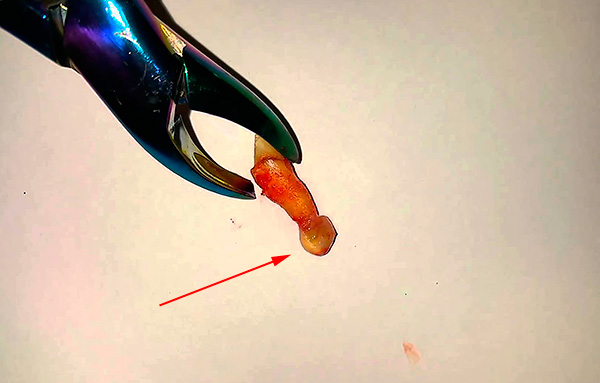
Next you will find out:
- What is a tooth cyst and why, in fact, it needs to be removed;
- What can happen if time does not cure a cyst on the root of a tooth (or not to remove it) and whether it represents a danger to the adjacent teeth;
- What are the current therapeutic options for treating a cyst (that is, conservative, without surgery) and how effective these techniques are in the long term;
- Should we hope to use depophoresis or a laser in the treatment of a tooth cyst;
- How is the resection of the apex of the tooth root with a cyst (in stages), how much is this operation today and is it a 100% guarantee of complete disposal of the root cyst;
- In some cases, teeth with a cyst are often removed away from sin, even without attempting treatment, and how this procedure is performed;
- Can a cyst after a tooth extraction remain or suddenly form in the hole and how it threatens the future;
- What very unpleasant complications can happen when a tooth is removed from a cyst, and what recommendations in the postoperative period can minimize unwanted effects ...
Today, even those who do not have a medical education are usually well aware of the fact that in the human body, under certain conditions, cysts can appear that present a considerable danger to overall health. So, in relation to the teeth, this problem is particularly relevant - on any tooth, be it a front tooth, a wisdom tooth or any other, for a number of reasons a so-called root cyst can form. Moreover, several such cysts can fall on one tooth.
What is a tooth cyst? The root cyst of a tooth is a neoplasm localized predominantly at the apex of the root and represents a kind of capsule, inside the shell of which contains fluid. Under certain pathological conditions, the cyst is able to grow over time, increasing in size.
The photo below shows an example of an extracted tooth with cysts on the roots:
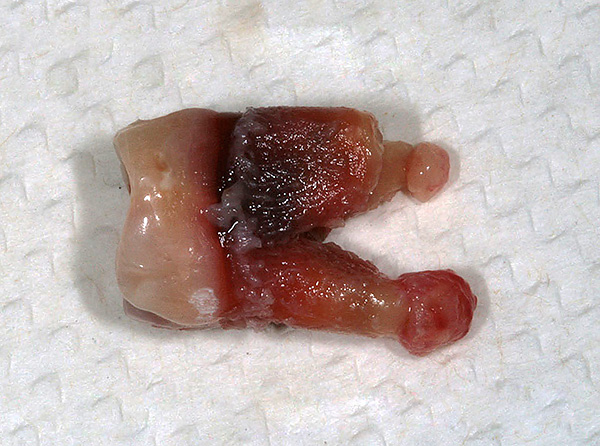
In many cases, it is important to have a tooth cyst removed in time to avoid the development of severe complications.Here you need to understand that the formation of a cyst is a kind of manifestation of the body's defensive reaction, which tries to isolate the infection that has penetrated through the root canal of a tooth into the surrounding tissue. First there is an inflammatory process on the root of the tooth, which often turns into a cyst.
It would seem, what is there to worry about - a cyst has formed, the infection is reliably isolated. However, the problem is that such isolation of infection from healthy tissues is not eternal: a carious or poorly treated tooth in the canals continues to constantly feed the neoplasm with bacteria, which creates a certain load on the immune system. And at some point in time, for example, after hypothermia, the body’s immune system is no longer able to restrain the onslaught of infection, and when this “time-mine” (that is, a cyst) breaks through, then we can talk about very serious consequences, including life-threatening (eg, blood poisoning, phlegmon).
That is why it is important to remove a tooth cyst in time or to cure it.
What can happen if you leave a tooth with a cyst, can you save it without an operation (without incisions of the gums with a scalpel) and what methods are there today for rescuing teeth with cysts - all this,as well as some other interesting points, we will continue and talk more ...
What happens if time does not cure a cyst on the root of a tooth?
As noted above, the main causes of tooth cyst formation are:
- Complications of caries (periodontitis);
- As well as non-professional canal treatment, turning into periodontitis.
In the course of its development, a tooth cyst undergoes 2 stages of periodontitis, in which at first there is a rarefaction of the bone tissue of the jaw near the root apex with indistinct borders, and only then, due to the intensive disintegration of healthy tissues, granuloma, cystogranuloma and (or) a cyst with clear boundaries are formed.
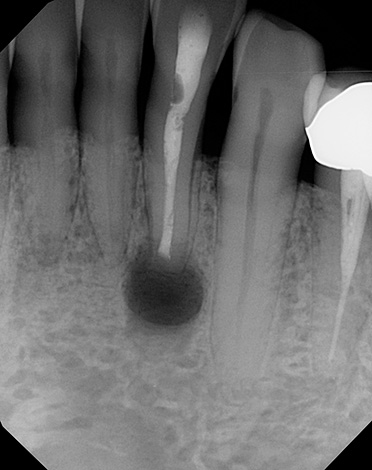
No dentist can say in advance exactly when the development of a cyst reaches such an apogee that the body can no longer localize the infection in a formed capsule. During exacerbation of the chronic process, purulent exudate spreads far beyond the borders of the cyst, often leading to very dangerous complications.
The following are just some of the possible consequences of continuous growth and "tearing" of the cyst:
- Purulent-inflammatory diseases of the maxillofacial region (periostitis, osteomyelitis, abscess, phlegmon, sepsis);
- Odontogenic sinusitis;
- Germination of cyst tissue in the maxillary sinus;
- "Thinning" of the jawbone (up to a possible jaw fracture while chewing solid food);
- Capture cyst roots of healthy teeth.
The picture below shows an example of a huge cyst that was not removed in a timely manner and, having increased in volume, grew to the roots of the adjacent tooth:
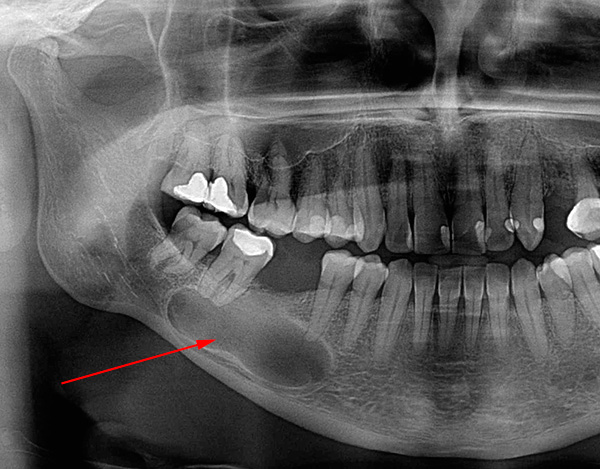
Comment dentist
In fact, a cyst is a time bomb, a kind of purulent bag that can slam so that at best the face will become twice as wide, and at worst the whole infection will rush to the maxillofacial area to the neck and pose a threat to normal breathing, until it stops, or death from intoxication of the body due to hematogenous (through the blood) spread of bacteria throughout the body.
When finding a tooth with a cyst in the upper jaw, purulent processes, leading to a threat to life, occur much less frequently than in the case of the lower jaw. However, due to the proximity of the maxillary sinus to the apex of the diseased tooth in the upper jaw, antritis, incurable by classical methods, can develop as a complication. That is, an ENT doctor who has no experience may prescribe cuckoo sessions to a patient for an infinitely long time.to release the maxillary sinuses from pus, antibiotics and other means, but success will be achieved only for a short time, since the infectious focus at the root of the tooth will continue to feed the inflammatory process.
Today, it is increasingly possible to hear that there is a definite connection between the presence of a cyst on a tooth and the development of cardiovascular diseases. How is the situation really?
About 10–15 years ago, information about the effect of apical infectious foci on the development of cardiovascular diseases was referred rather to theoretical speculation rather than to real facts. However, today the medical community listens to the data of a mass study of 508 people with an average age of 62 years, suffering from various heart diseases. Acute coronary syndrome was noted in the group with multiple infectious foci on the roots of teeth, and a small percentage of individuals with single foci had an unexpressed coronary artery disease. More than half of the "cores" (about 60%) had at least one inflammatory process at the root of the tooth.
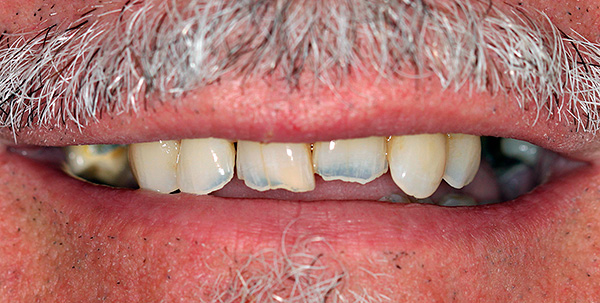
Of course, from an evidence-based point of view, the study is not ideal,since the presence of cardiovascular diseases imprint and such moments as obesity, smoking, diabetes, etc. Therefore, today experts consider the presence of root cysts on the teeth only as another risk factor for the health of the heart and blood vessels.
Therapeutic (conservative) treatment of cysts
Based on the fact that a cyst can carry so many risks to human health, immediately after its discovery (usually from a snapshot), the quite natural question arises of the need to remove it. Often, a tooth is extracted with a cyst on the root.
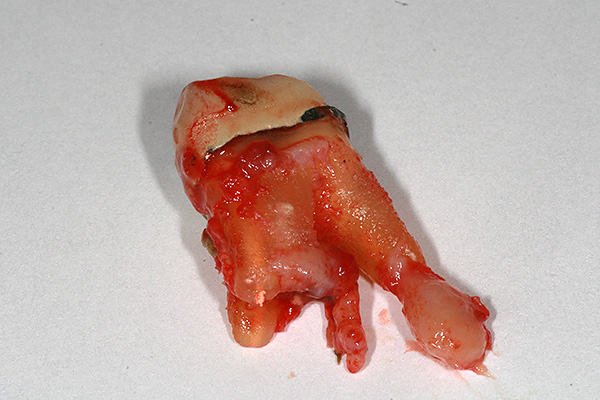
But is there really no way to not only do without removing a tooth with a cyst, but in general - without any surgical intervention associated with, for example, cutting out a cyst? Maybe it can somehow be cured conservatively?
Before considering modern methods of “removing” a cyst without surgery, let us first get acquainted with some features of the tumors that may be present on the tops of the tooth roots:
- A granuloma is an overgrown granulation tissue in the apex of the tooth root that appears in response to root inflammation.It is believed that the granuloma is the initial stage of the cyst, and that, gradually increasing, the granuloma sooner or later becomes a full-fledged cyst. In practice, sometimes there are large (up to 10-12 mm in diameter) granulomas, although images of the tooth root persistently show a cyst;
- Cystogranuloma is a transitional stage between the granuloma and the cyst. It differs from the previous formation by some features of tissues (although at present not all experts believe that cystogranulomas should be distinguished as a separate type of neoplasms);
- And finally, a cyst - in its structure it resembles an egg, which contains a certain amount of fluid (pus) under the shell.
Generally speaking, it is not so important whether a granuloma or cyst formed on the roots of a tooth. A cyst differs from a granuloma, primarily in terms of histology, but in the practice of a dentist to obtain a positive result of treatment there is no fundamental difference between these forms: the treatment is carried out using the same methods without taking a tissue for biopsy.
On a note
According to the target image and even with the help of CT, it is difficult to determine with 100% accuracy which form of the inflammatory process is present at the root (s) of the tooth.Usually visible area of enlightenment with clear contours, usually round or oval. This “circle” can be located not only at one root, but also capture 2-3 roots of one tooth and even take place in close proximity to the root tips of neighboring teeth, hinting the dentist on the scale of the tragedy.
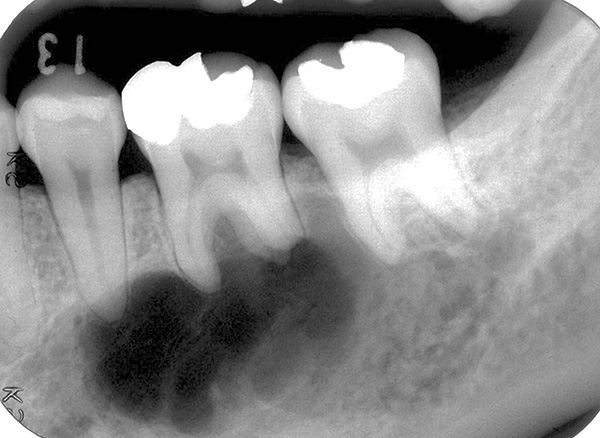
The key point that arises in practice is to make a decision: is it worth starting a treatment for a cyst at all, or should you resort to removing a part of the tooth root, or should you remove the tooth completely with the cyst?
The final decision is influenced by the following factors:
- There are protocols that regulate the possibility of preserving a particular tooth;
- The qualifications and experience of the dentist strongly influence the final decision (an inexperienced doctor may not have other options than to just remove the problem tooth from harm's way);
- The high level of equipment of the clinic creates the prerequisites for the possibility of conservative treatment of cysts with the preservation of the tooth.
As for the protocols that doctors are guided by - it should be understood that the documentation in many ways does not keep up with technical progress,and the compositions (pastes) developed today, which are placed in the canal to “remove” a cyst, often make it possible to achieve success even with enormous granulomas and cysts.
In addition, in recent years, cases of conservative treatment of large-volume root cysts without the use of classical calcium hydroxide-based pastes are increasingly being described. There is an opinion that it is sufficient to qualitatively process the system of tooth canals using sodium hypochlorite and ultrasound, after which, thanks to sterile canals, the cyst simply ceases to be necessary for the body and disappears itself within 4-15 months.
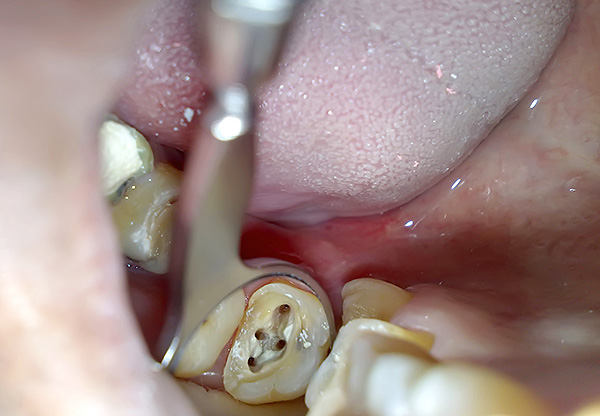
Conservative treatment of a tooth cyst (that is, its “removal” without surgery) is a long process, but today it doesn’t necessarily look like a routine. A routine treatment option for a cyst is to visit a doctor almost every day to inject new portions of calcium hydroxide into the canals.
When using modern methods, the patient, after a single visit to the doctor, walks with the filled canals and temporary restoration, periodically visiting the dentist to analyze the current state of the cyst from the tooth image.The frequency of visits is chosen by the doctor, but usually the reception is made after 2 weeks, a month, 3 months, 6 months, a year and two years.
A small summary: an experienced doctor with the appropriate equipment may well save a tooth from removal even with a large cyst. It should, however, be borne in mind that failures can also be - sometimes after numerous attempts at useless treatment, the tooth is simply removed along with the cyst.
The use of depophoresis and a laser to remove a tooth cyst
One of the modern methods of removing a root cyst with tooth preservation is the use of depophoresis, as well as a laser. Let's see if these methods really allow to “destroy” a cyst on the apex of a tooth root once and for all.
The use of depophoresis in dentistry has its roots in Germany, but in Russia it has been actively exploited since about 1990. During this time, the technique has gathered around itself both fans and opponents, who even claimed that depophoresis for endodontic treatment is totally unacceptable.
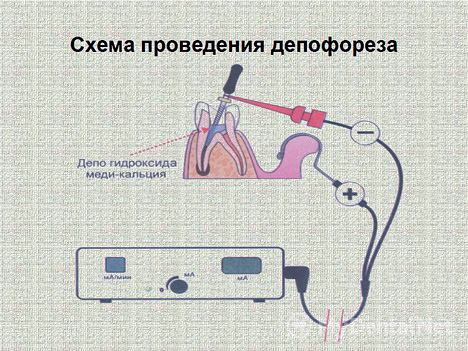
On a note
The meaning of depophoresis is the injection of molecules and ions of strong anti-inflammatory and bone-regenerating preparations under the action of an electric current. In the case of treatment of a cyst of a tooth, one electrode is connected to the transitional fold of the oral cavity, and the other is placed in a channel together with copper-calcium hydroxide. The treatment involves three visits: the last in the channel (channels) are injected with alkaline atatsamit-cement to the upper third.
One of the areas of application of depophoresis was the treatment of inflammatory processes on the tops of the roots of the teeth during periodontitis (including radicular cysts). In fact, depophoresis with calcium-calcium hydroxide is a kind of symbiosis of drug treatment and canal filling. And this is a kind of dream of any bad dentist: you don’t need to develop the entire canal, walk along the most unpredictable curvature, fight the impassable canals of the resorcin-formalin tooth, don’t necessarily try to implant anti-inflammatory material as close as possible to the apex, and you can even accidentally break the top of the instrument or make perforation - depophoresis, according to the authors, “will write off everything”.
Thanks to this technique, the restoration of bone tissue in the focus of inflammation is slow but sure. According to some authors, the likelihood of success of such treatment is about 90-95% with an average period of 10 to 12 months.
At the same time, many experts are inclined to believe that depophoresis with copper-calcium hydroxide should be used only as a last option, when other conservative methods for removing a tooth cyst are not beneficial. In general, depophoresis today is not a common method, even with the positive results of treatment described in the literature.
Unlike depophoresis, the use of a laser to remove a cyst flashes in the promotional offers of dentistry much more often. However, how justified is its use?
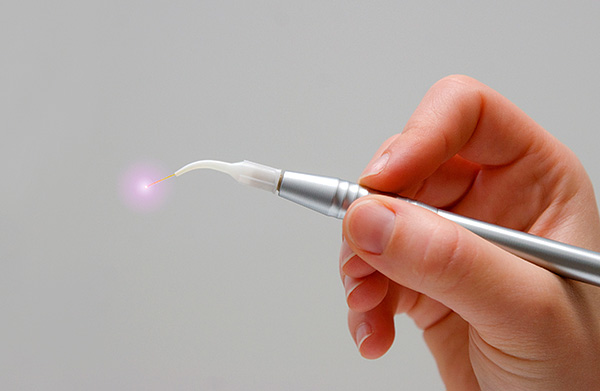
Speaking about laser treatment of cysts, they mean two directions of its use, namely:
- Additional antiseptic treatment with laser channels (sterilization);
- And also trans-channel laser dialysis.
As for the first direction: laser canal sterilization of dental canals has the same purpose as with ultrasonic treatment of canals with sodium hypochlorite.A number of specialists consider the use of a laser for such channel processing as not entirely justified, since a laser, unlike the method of sounding a channel with hypochlorite, cannot equally effectively remove organic matter. The laser can be much more useful in surgical methods of removing cysts, which will be discussed below.
As for trans-channel laser dialysis, this technique involves introducing a laser light guide into the dental canals, under the radiation of which, according to the advertising materials of the clinics, microbes die (literally evaporate) and the cyst cavity becomes sterile. Unfortunately, the use of a laser in treating a cyst is more of an advertising ploy, rather than a real need, since, in addition to the laser, this method then also necessarily uses all the same drugs for introducing a cyst into the cavity, which are used without using a laser.
But as fashionable, and easier to justify the increased cost of the procedure - this is a laser ...
What is useful to know about some tooth-saving operations.
Above, we talked about the conservative (therapeutic) treatment of a tooth cyst, that is, when the dentist does not perform the operation and does not cut out the cyst, but only creates certain conditions for its resorption.Typically, such treatment lasts an average of 6-12 months, sometimes more, but without surgery.
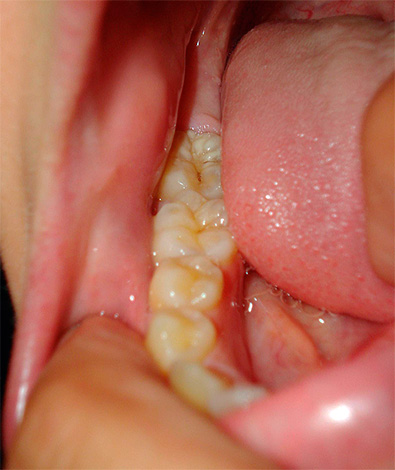
The removal of a cyst in the truest sense of the word is performed by surgical methods. Among them are:
- Resection of the apex with cystectomy (removal of a cyst);
- Hemisection;
- Crown radicular separation.
The last two tooth-preserving methods are used in the practice of doctors not so often, and leading is the resection of the apex of the tooth root along with the cyst.
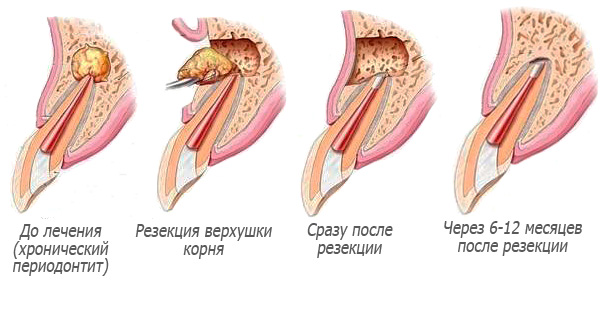
Usually this operation is carried out as follows:
- At the first stage, preliminary training is carried out, which may include consulting dentists of different profiles (therapist, orthopedist, periodontologist) - the question of the feasibility of maintaining a tooth with a cyst is solved, and the patient’s health status is determined;
- The periodontist conducts professional oral hygiene (removal of tartar and plaque), the dentist-therapist seals the canals (with cement, gutta-percha or the Termafil system);
- At the third stage, the dentist-surgeon or maxillofacial surgeon starts the operation to remove the cyst.Anesthesia is carried out according to generally accepted rules - most often clinics operate under local anesthesia when a person is conscious, but in certain clinical situations and according to indications they resort to anesthesia - the introduction of a patient into an artificial sleep;
- After the operated area is anesthetized, the dental surgeon proceeds to the gum incision along the transition crease in the projection of the top of the tooth root affected by the cyst, and then using the cutter creates access to the cyst (cuts a window into the bone tissue);
- Then the cutter cuts off the top of the tooth root (as a rule, at an angle to see the quality of the canal filling by the therapist);
- After this, the contents of the cyst cavity are scraped;
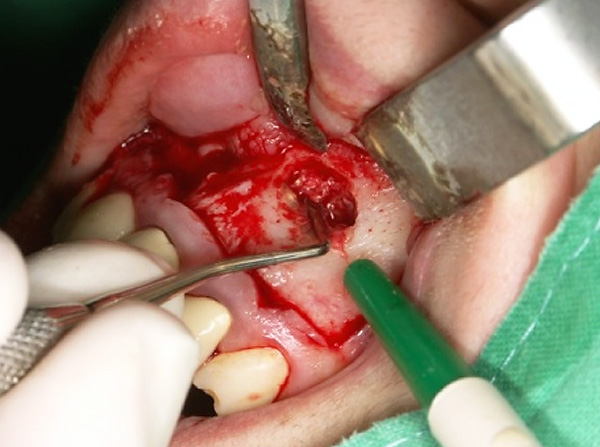
- After scraping, it is required to fill the cyst. For successful healing, xenografts or materials made from bone chips and the patient’s blood are suitable;
- Stitching helps reduce the lumen of the intervention area, relieve the wound from infection and speed up its healing with maximum comfort;
- At the end of the procedure, complex anti-inflammatory and antibacterial therapy is prescribed.as well as control examinations (pictures are taken once a month in order to track the dynamics of bone recovery in the area of the removed tissue).
Professionals perform resection of the tooth root with a cyst in about 20-30 minutes. This operation is today one of the most common and effective ways to preserve teeth, whose roots are affected by a cyst (the cost of resection of the tooth root in clinics today is about 10,000 rubles)
The success of the event directly depends on each stage carried out ideally. If, for example, the cyst is not completely removed, the area of the removed cyst is not filled with special materials, or antibiotic therapy is not carried out after the operation, then with a high probability this may lead to a recurrence of the infection process. In such cases, quite soon the tooth is again under threat of removal.
Feedback:
“Five years ago, when I fell, I hit my face so that both upper anterior teeth moved inside. I didn’t go to the doctor then, just waited for them to cease to stagger. I think that was my big mistake. After a couple of months, when the teeth were no longer loose, a small pimple emerged over the left one, pus was leaking from it.She ran to the dentist, there was a cyst on the x-ray. At first they wanted to remove the tooth, but then they decided to perform an operation on a cyst and remove it. Before that, nerves were removed from the front teeth and glued together with each other using splinting. After the operation, the doctor said to come and do bone grafting, as the cyst was large. But I never came, as I was very afraid that they would cut it again. 5 years have passed, everything is fine with your teeth ... "
Elena, St. Petersburg
In which cases the teeth with a cyst are most often removed, and how it is implemented
If a tooth with a cyst cannot be cured, then it is assumed that it needs to be removed as soon as possible - it has already been said above how risky it is to continue to “grow” the cyst. Especially often the tooth is removed in cases where, due to a cyst, an aggravation has already occurred with swelling of the face, fever, difficulty opening the mouth, severe pain, etc.
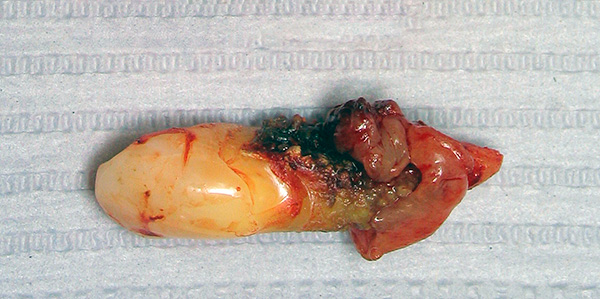
However, the final decision, whether to remove a tooth with a cyst, or to try a treatment, is taken by a dentist. In this case, the doctor is guided not only by officially existing testimony (protocols), but also relies on his many years of experience, and often on the opinions of colleagues from related medical specialties.These are not only dentists of other profiles (dentists-therapists, orthopedists, surgeons, periodontologists, orthodontists), but also neurologists, cardiologists, otorhinolaryngology, etc.
For a better understanding of the situations, here are two typical examples.
A 78-year-old patient (man) with a burdened history was brought to the dentist-therapist about the treatment of the front tooth with a cyst. Namely - the patient is registered with the district therapist for coronary heart disease, the surgeon for the disorders of the musculoskeletal system. Simply put, a person is not only difficult to move around, but one can say in advance that he does not tolerate long-term treatment.
Is it worth it to remove a tooth with a cyst or is it better to prefer a conservative treatment option?
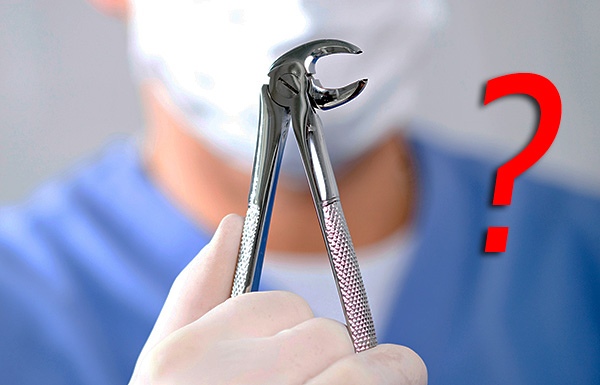
Formally, the picture shows a small cyst (2-3mm), the front tooth is fixed, single root, the root is even, but can a seriously ill person undergo many months of canal therapy and frequent visits to the doctor? And how important is this tooth for the future for prosthetics? If you decide to remove a tooth with a cyst, how high is the risk of serious heart problems in a patient right in the doctor's chair?
Today, these patients in dentists is a lot, and each case is individual. As a result, the doctor himself often has no answers to all these questions, so common sense and advice from colleagues come to the rescue.
On a note
If a patient with a weak heart applies for emergency care (a tooth with a cyst has become aggravated and has led to asymmetry of the face), then the dentist-surgeon should perform an urgent tooth extraction under the supervision of the attending physician (local physician, cardiologist, ambulance team, etc.). ). Often the risk is so great that the removal is performed in a hospital and permanent monitoring of vital body functions.
In case of chronic periodontitis with a cyst, when the symptoms are not so bright, and there are no serious risks to life and health, the dentist must weigh the pros and cons, find out the opinions of colleagues and then decide whether to treat or remove.
And now an example from a different clinical situation, which occurs much more often (almost every other day). A 45-year-old male patient turned with a large number of missing teeth, which is going to be replaced in the near future.The orthopedic surgeon has not yet had consultations, but the patient decided to cure the lower right wisdom tooth with the cyst, since it is the last hope for a “bridge” as an end support.
Often people, turning to the dentist, by some kind of feeling or special intuition, assume the importance of a certain tooth for the future and in every possible way try to convince the doctor of the need to save the tooth. If the doctor is inexperienced, then he will pay attention only to a snapshot of the tooth - and, for example, he will see only wide flat canals, bent roots and a small cyst (granuloma), as well as ease of access to the canals, since the patient can open his mouth wide. But the doctor can notice 2-3 degree of tooth mobility only in the middle of the treatment, when it is so hard to tell the patient: “You know, but the tooth, it turns out, is mobile”. It is like admitting your incompetence.
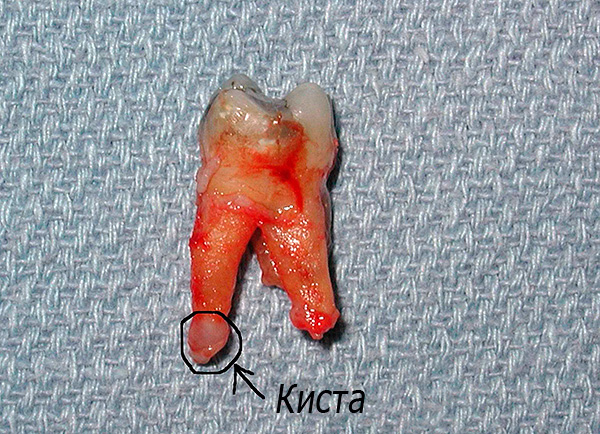
Therefore, it often happens that the young doctor successfully finishes the treatment of a tooth with a cyst (2-4 months) and sends the patient for prosthetics, and the dentist, checking the tooth for mobility, states the need for its removal and absolute unsuitability as a support for the bridge.Due to the heavy load on the “bridge”, in the coming months, the front support, which was previously the most reliable, would also be mobile.
That is, the first doctor who did not check the tooth for mobility and did not consult with a colleague does not have clinical thinking, and one-sided solutions (by inexperience or “on paper”) lead to the fact that tooth treatment with a cyst becomes a distant prospect, to say the least , useless.
What else can stop a competent doctor to treat a tooth with a cyst:
- Serious orthodontic anomalies (bite pathology);
- Poor oral hygiene of the patient;
- Significant loss of the coronal part of the tooth;
- Serious errors of previous doctors in the canal (s) of the tooth, made during endodontic treatment;
- Prerequisites for tooth overload when chewing food;
- Pathological abrasion of enamel severe;
- The large size of the cyst, when it creates serious risks for the roots of adjacent teeth;
- The desire of the patient will certainly remove the tooth.
In general, it can be said that there are many cases where stubborn long-term treatment of a cyst was unsuccessful and carried a train of frustrations for the patient (and the doctor).
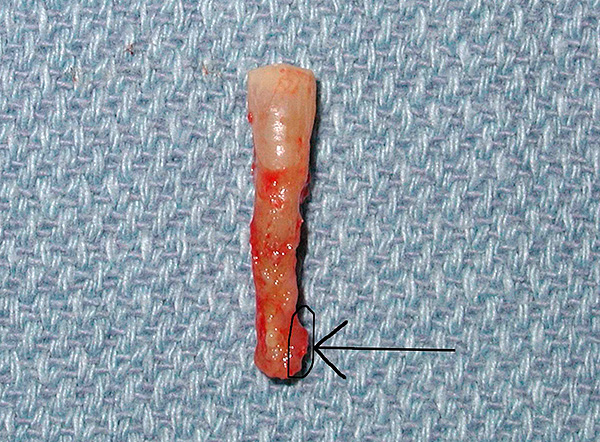
On a note
By the way, about the desire of the patient to by all means remove the tooth. The dentist has no right to refuse the patient's request, but before that, a competent doctor, assessing the clinical situation, should argue for the possibilities of treatment of the tooth, if any. For many reasons (including psychological and financial), a patient cannot always afford long-term treatment of a tooth with a cyst, not to mention a conservative surgical intervention (resection of the root apex). Therefore, his request has the right to satisfaction after he signs the document “Informed voluntary consent to medical intervention”.
Technically, tooth extraction with a cyst is almost the same as tooth extraction without a cyst. Most often, the procedure is implemented using tongs and elevators.
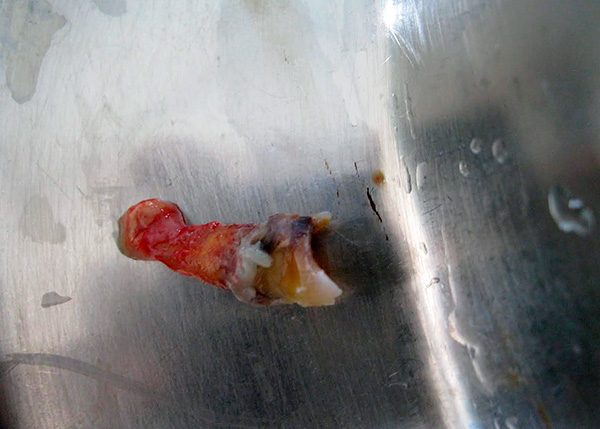
How is a cyst or granuloma removed?
When a cyst is almost always removed, the cyst is evacuated along with the root of the tooth, but it also happens that it breaks off from the top of the root, or even the top of the root itself breaks off. When the cyst is torn off, the surgeon scrapes the cavity with a curettage spoon or ironer. In case of breaking off the root, it can be removed by elevators, a curettage spoon,or the method of cutting out a drill with the subsequent wound closure.
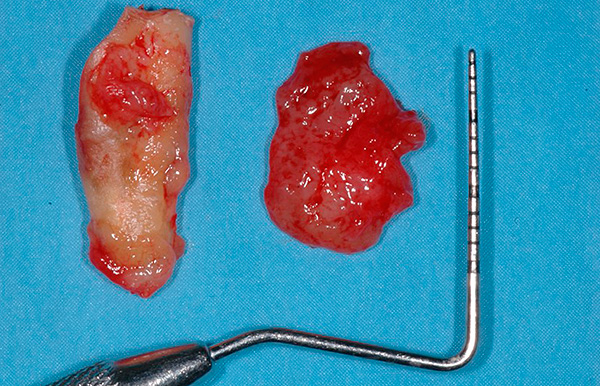
Is it possible to do without pain when removing a tooth with a cyst?
Before any surgery, the dentist always performs anesthesia. The result of the work largely depends on its quality, since only in a calm environment can you qualitatively remove a tooth with a cyst — neatly and with minimal trauma to the tissues surrounding the tooth root. That is why modern dentistry has a large arsenal of tools (anesthetics and components), which almost always allow for any, even difficult tooth extraction without pain in the patient.
Can a cyst after a tooth extraction remain or form in the hole, and how does this threaten?
Suppose that everything was left behind for the patient: the doctor safely extracted the roots of the tooth with a cyst, stopped the bleeding and made recommendations. But did not check the quality of removal of the cyst!
Is it possible, in principle, to understand that all pathological tissue is scraped from the bottom of the hole and its walls, if due to increased bleeding, the view is often closed? And what will happen if part of the cyst remains in the hole?
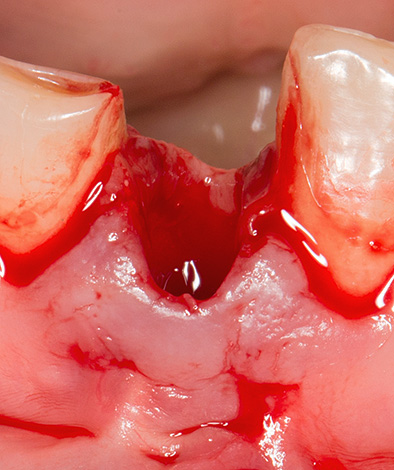
A cyst that the dentist left in the hole after a tooth is removed is called residual. And nothing good for the future, this focus of infection does not carry. Residual cyst can stand still for many years to “shoot” in the future in the form of swelling on the face (flux), abscess, phlegmon, sinusitis, or grow into the maxillary sinus, mandibular canal, etc. Or it initially will not allow the well to heal normally in comfortable conditions - an alveolitis will arise, which will be extremely difficult to cure without eliminating the root cause.
There is no way that a cyst itself, “out of nothing,” is formed after a qualitatively performed tooth extraction. If it was formed, it means that not all pathological tissue was removed from the hole, or even the top of the tooth root could be broken off during the extraction procedure. An abandoned cyst or granuloma has a tendency to grow and complicate - it is worth remembering.
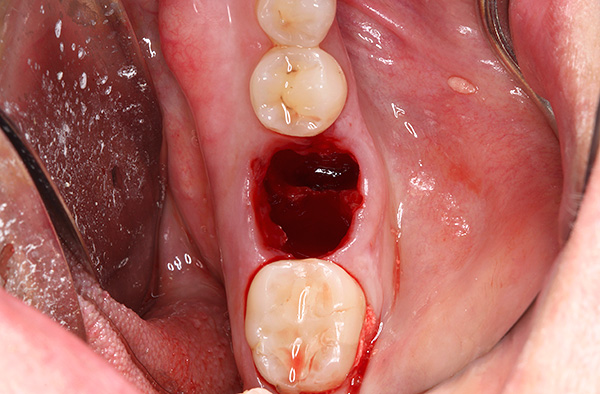
Feedback:
“I went a couple of months ago to our hospital, where I had the back upper tooth that had tortured me for a long time. Something cracked during the removal, but the doctor said everything was fine. Gave a list of drugs and sent quickly home, because the people he had a full corridor. On the second day, I realized that I was dying: my face was swollen, the temperature was 39, and the pains were no longer removed.I ran to this doctor, and he almost came to me from the doorway: they say, it happens that you have to heal yourself with what you have. I spat and went to a private trader, and there they took a picture of me. The picture found a piece of root with a cyst. A little fragment, but with a huge cyst, as the new doctor said. He made an injection and in 15 minutes removed this dirty trick. The pain disappeared like a hand, the temperature returned to normal and the edema subsided. So in this matter the main thing is to find a good specialist and not really rely on Zododer-butchers in clinics ... "
Vitaly S., Stary Oskol
Possible complications and methods of their prevention
In some cases, after the removal of a tooth with a cyst, patients are confronted with situations that are incomprehensible to them (and very unpleasant), which sometimes cause almost panic. In particular, no patient of the dentist is fully insured against:
- Prolonged bleeding from the hole;
- Alveolitis;
- Perforation of the maxillary sinus;
- Fracture of the jaw (already at home, for example, during meals);
- Paresthesia (persistent numbness of part of the face);
etc.
Fortunately, the last three complications after removal of a tooth with a cyst are quite rare.
Perforation of the maxillary sinus sometimes occurs due to the proximity of the roots of the teeth of the upper jaw (mainly the upper 4, 5, 6 and 7 teeth) - for example, when the dentist-surgeon does not work very carefully. In addition, the germination of a cyst in the maxillary sinus is possible - in this case, after removal of the tooth with the cyst, a message of the sinus and oral cavity occurs.
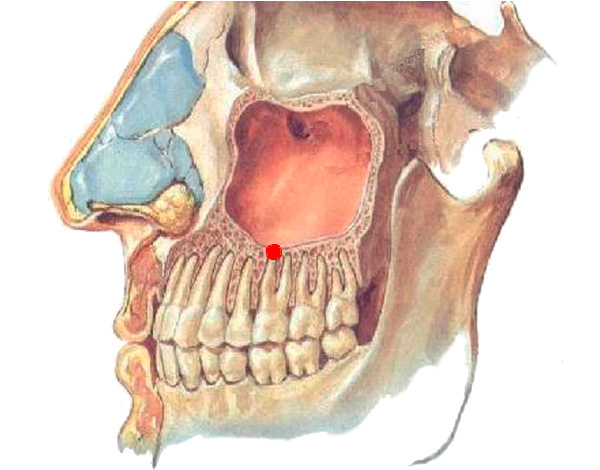
A dentist can test the presence of the perforation of the maxillary sinus after tooth extraction as follows:
- The patient pinches the nose and try to exhale through it. When perforation of the sinus air evacuates from it into the mouth;
- If you inflate the cheeks, then when perforating the maxillary sinus, air immediately goes into the nasal cavity (this technique should be used only in the extreme case because of the risk of throwing microflora into the sinus).
On a note
Sometimes perforation occurs when the wrong tooth extraction technique: excessive pressure of the instrument on its root or root apex, or directly on the bottom of the sinus.
Paresthesia of the facial areas (numbness) is characteristic of cases where a cyst grows into the mandibular canal where the nerve passes. Less often - with excessive trauma interventions, when the nerve fiber is damaged directly by the instrument or is squeezed by hematoma.

A jaw fracture after tooth extraction may occur due to significant bone loss,when the cyst occupied a significant volume of the jaw (more than 1 cm in diameter).
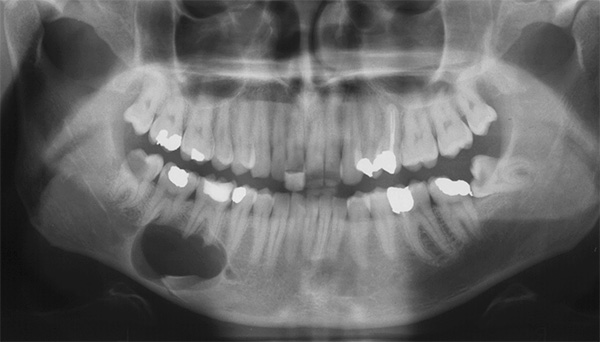
Prolonged bleeding from the hole and alveolitis occur in practice more often than other complications.
The causes of unstoppable bleeding can be different: from damage to large vessels during tooth extraction to the patient's taking drugs that thin the blood, or against the background of high blood pressure. The risk of deterioration in the general condition of the patient is possible with continuous blood loss through the hole for more than 6-12 hours. Therefore, in the case of prolonged bleeding, it makes no sense to wait for hours for the blood to stop itself - it is better to take timely measures.
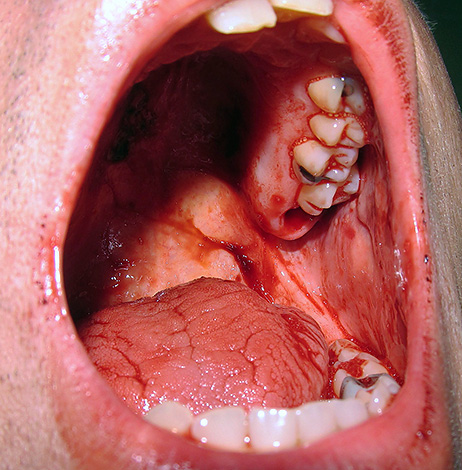
Before visiting the doctor should:
- Measure blood pressure and normalize it by taking medications prescribed by the therapist;
- Stop taking anticoagulants;
- Place a sterile gauze ball on the well and press it for 15-20 minutes. The main thing is the force of compression (but without fanaticism), since the hemostatic effect depends on this factor;
- With the ineffectiveness of the previous method, it is possible to drop a little 3% hydrogen peroxide into the middle of a sterile gauze ball and also firmly hold the tampon between the hole and the opposite tooth (hydrogen peroxide has hemostatic properties);
- In the extreme case (if there is no possibility to get to the doctor at all), you can buy a hemostatic sponge in a pharmacy and put it on the well or partially in the well, also pressing on top for 10-15 minutes with a sterile gauze pad.
Alveolitis (inflammation of the hole after tooth extraction) may be due to poor cleansing of the wound from cysts and tooth fragments. Often, the patient himself is also to blame for the development of alveolitis if the recommendations of the doctor are not followed. The consequences of such abnormal behavior are different: severe pain in the hole, swelling, fever, putrid breath (and even more severe, up to osteomyelitis and abscess).
Key recommendations after tooth extraction with a cyst
Now let's see what to do after removing a tooth with a cyst so that the hole does not hurt and heal faster. If the dentist’s tactic for removing a tooth was correct, then further prevention of complications depends only on the patient to whom the doctor must issue a list of recommendations.
Unfortunately, it often happens that the dentist does not inform the patient about the actions after removing a tooth with a cyst (either it forgets or simply does not want to spend time on it).This happens both in Moscow and in the regions - in ordinary hospitals, where every working day a dentist-surgeon exhausted by “kilometer” queues of patients removes teeth in batches, and the price of the question can be ridiculous (200-300 rubles), or the service is free .
Below is a universal list of recommendations after the removal of the tooth (with and without cysts), quite a "running", according to the positive reviews of medical specialists:

- 3 hours not to eat;
- Apply a cold compress to the area of removal from the side of the cheek for 15-20 minutes every 2 hours, avoiding hypothermia;
- For 4 days, refrain from coarse, spicy and hot food;
- Eliminate heavy physical exertion, hot showers, baths, saunas, steam rooms, etc .;
- Do not disturb the wound (do not climb into it with your hand and toothpicks, protect from any irritants);
- Maintain an adequate level of oral hygiene (use a soft toothbrush, without neglecting to brush your teeth near the hole).
These tips are maximally adapted for most patients. However, even with the implementation of these recommendations, there is no 100% guarantee that after removing a tooth with a cyst, the hole will heal without problems.
The likelihood of problems with compliance with these recommendations will be minimized in the case of simple tooth extractions that are not in the acute stage. If the cyst was large, and the pus literally oozed out of the hole after tooth extraction, then we are talking about the need for a doctor to use an additional arsenal of tools: antibiotics, antihistamines, painkillers and wound healing agents.
Anyway, it is useful to listen to your body and be guided by common sense. And if, for example, the hole hurts for a long time, or incomprehensible sharp splinters stick out of it, it is better to see the doctor once more, not hesitating to disturb him.
Interesting video about the modern approach to the problem of tooth cyst
An example of the removal of a huge mandibular cyst

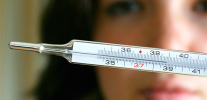
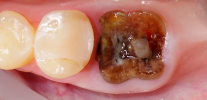
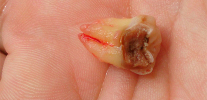
Hello, I'm pregnant, 19 week. I was told that I have a tooth cyst. They said that it is necessary to remove. How is it done with anesthesia? I'm afraid it will be tomorrow. I hope I won't lose the baby.
Hello! If we are talking about resection of the apex of the tooth, then most often it is carried out under local anesthesia with an anesthetic safe for the fetus (this always takes into account the presence of contraindications). If we are talking about tooth extraction with a cyst, then more often this procedure is also performed under local anesthesia, without anesthesia (that is, it is not about tooth extraction “in a dream”).
In principle, the doctor does not have the right to begin any manipulation without obtaining your consent and not determining the risk of the upcoming operation.So be sure to get a detailed consultation: what will happen and what drugs will be used.
Hello! Son is 17 years old. It is recommended to put braces. They made a panoramic picture and it turned out that there was a cyst on the bottom six. They faced a dilemma: one doctor suggested surgically removing a cyst. Another doctor is categorically against this method, arguing the high risk of paresis. Is it so risky to have a surgery? Thank.
Hello! How many doctors, so many opinions, especially in difficult situations, and here is not so simple. The proximity of the mandibular canal to the operative zone may indeed have certain risks of developing paresthesia (from 2-3 weeks to several months there is a feeling of numbness after the visit to the dentist). Such problems in patients can be observed even after the work of a first-class specialist.
I will not undertake to comment on the opinions of those two doctors about whom you speak, if only because they are not aware of the details of the clinical situation and there are no panoramic images.However, it is quite obvious that for making a decision now it is useful to get more information by consulting another 1-2 experienced specialists, who may look at the problem from a different angle and, perhaps, suggest not to remove the cyst, but try to cure it. without deletion.
Thank!
Good day! Tell me, please, after removing a tooth with a cyst, how long can a purulent liquid with blood flow out of the hole? And what measures should be taken if there were aching pains and swelling? The doctor said taking amoxicillin to help the body cope. Is everything right?
Hello. After the extraction of the tooth, the exudate can be released within 1-2 days. To improve the conditions of its discharge, the dentist-surgeon often makes an incision in the area of the transitional fold, which is a mandatory measure for some purulent diseases of the tooth (with periostitis, for example). If there is aching pain and swelling, it is important to see a doctor for a checkup to rule out something serious.
An antibiotic prescribed for you is a completely adequate measure, which is necessary for purulent infection in order to rule out postoperative complications.
Hello, removed the cyst, but the lump on the gum remained. Is this how it should be?
Hello, Denis. In the first 3-5 days after surgery, edema is possible (perhaps you call it a “lump”), then the edema should subside.
In addition, the lump may remain if the cyst membrane is not completely removed or the postoperative wound has inflamed. In this case, this is not normal, and if the lump remains, then the chances of self-healing are extremely small. Repeated surgery (revision of the cyst bed) or tooth extraction will be required. Therefore, if the condition of the gums does not improve every day, then it is necessary to consult a doctor to clarify the situation and choose the tactics of further treatment.
On the outer side of the gum a lump with pus is visible, and a picture was taken on the inner side of the gum, the picture showed nothing. The doctor said that you need to wait a bit. And if it gets worse? How long should I wait and what to do?
Hello Anna. No need to wait. It is possible that you have a so-called fistula with purulent discharge. This is a sign of the presence of a nidus of infection.If the assumption is true, then this will not work out itself - urgent endodontic treatment is necessary (that is, treatment of the canals of the tooth). Otherwise, the situation may result in the loss of a tooth. So I recommend to go to another doctor (to get an additional independent opinion) and clarify the situation.
Good day. Tell me, please, is it possible to remove a cyst from the top three without removing the bridge? Two years ago, I did implantation and really asked the doctor to remove all my roots (namely, the roots, since there were no tops, the pins were inserted, and crowns were placed on them). My body is prone to cysts. But the doctor decided to keep "my teeth." All, of course, healed. And they did it very well, but two years after another hypothermia, a cyst again! Took a picture and all 6 of the front upper teeth with granulomas. And on deuce and triple cyst. The bridge is worth quality. Is it possible to ruin everything ?!